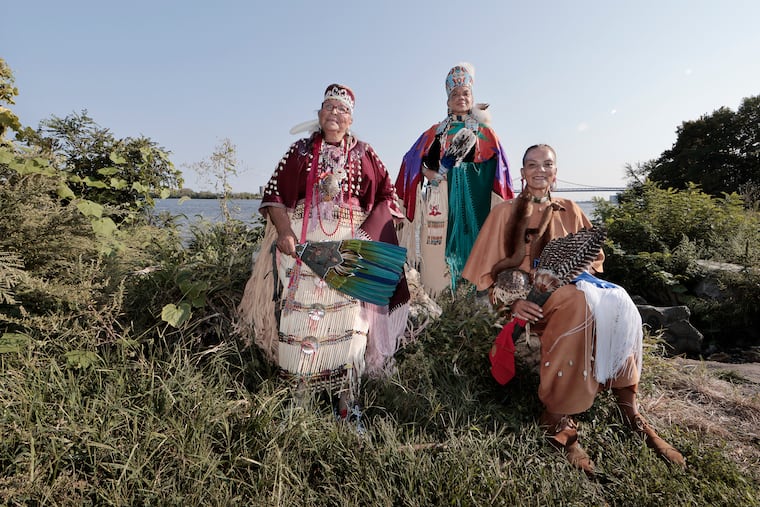Native Americans gather in Philly for a powwow on the site of a historic treaty with William Penn
They came to Penn Treaty Park from across the city and the country to dance, share stories, see friends, and assert their continued presence on this land.

Three hundred forty years after William Penn and the Lenni-Lenape Indians are said to have exchanged vows of brotherhood on the shores of the Delaware River, Indigenous people from two dozen tribes gathered Sunday for a traditional powwow at the same spot. They came to Penn Treaty Park from across the city and the country to dance, share stories, see friends, and assert their continued presence on this land.
“They thought they had moved us all, or annihilated us all,” said Frank Adams, chief of the Upper Mattaponi Tribe, who traveled from Virginia to attend the powwow. “The Lenape tribe signed a treaty and were given a bunch of land and properties in this area that have now been all taken away from them, as the treaty was broken.”
The all-day powwow to commemorate the 1682 Treaty of Shackamaxon began with the grand entry. Dancers and dignitaries in formal regalia walked into Penn Treaty Park carrying flags representing their nations, while a group of Indigenous drummers called the Red Blanket Singers played. Powwow regalia conveys information both about the individual wearing it and the tribe she represents, said Cory Ridgeway, one of the dancers. Each style of dance requires different elements of clothing.
Ridgeway herself dances in the women’s fancy style, which requires a shawl over the shoulders; her kids jokingly describe it as “if Jane Fonda had a dance style.” The family spends many weekends from April to November traveling to powwows, Ridgeway said. It’s a chance to connect with friends and relatives, to laugh, to eat — but it also has a deeper purpose.
“It’s a way of helping our family and children stay grounded in our culture,” said Ridgeway, who is part of the Nanticoke Tribe from Millsboro, Del. “They were dancing as soon as their feet could touch the ground. They had their first regalia as newborns.”
» READ MORE: Columbus Day is now Indigenous Peoples’ Day. Here’s how that happened.
In addition to the social element, the powwow aimed to educate attendees about some of the most pressing issues facing Native Americans today. To that end, red dresses hung from trees in a corner of the park, drawing attention to missing and murdered Indigenous women.
“Our people are never found, because they’re never looked for,” said Cornelia Dimalanta, executive director of the Native American House Alliance, the nonprofit that hosted the powwow. “That’s why we do this — to symbolize that we are here.”
“Our people are never found, because they’re never looked for. That’s why we do this — to symbolize that we are here.”
The Alliance, founded in 2019, provides social services to the more than 6,000 Indigenous people living in the Philadelphia area today. In addition to direct services, the organization is pushing Philadelphia to create a commission for Native Americans to fund job development, education, and housing, Dimalanta said.
» READ MORE: A Chester County woman wants to donate a Native American burial ground. It’s a complicated process.
After the grand entry, Mayor Jim Kenney addressed the gathering.
“Much time has passed since they called this land Shackamaxon,” he said. “The name and reputation of brotherly love continue on in the spirit we see and feel here today.”
As the day wore on, Ridgeway’s 8-year-old son, Sahkakwenao, raced to the center of the meadow with the other children for the “Tiny Tots” dance; when the drumming began, he shimmied and shook with the other children, his regalia glinting in the sun.